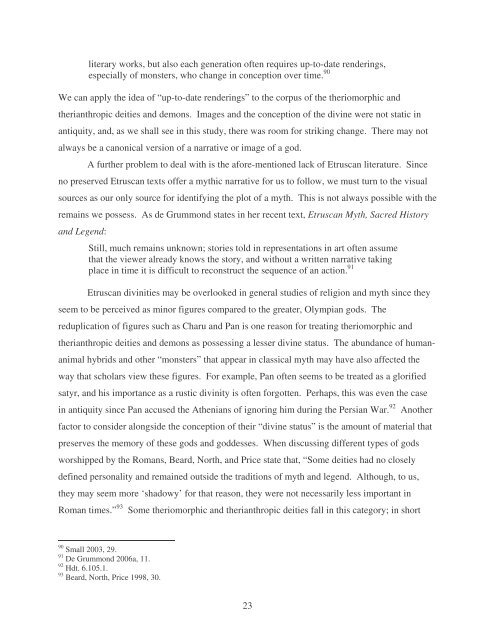Final Draft - Preview Matter - Florida State University
Final Draft - Preview Matter - Florida State University
Final Draft - Preview Matter - Florida State University
You also want an ePaper? Increase the reach of your titles
YUMPU automatically turns print PDFs into web optimized ePapers that Google loves.
literary works, but also each generation often requires up-to-date renderings,<br />
especially of monsters, who change in conception over time. 90<br />
We can apply the idea of “up-to-date renderings” to the corpus of the theriomorphic and<br />
therianthropic deities and demons. Images and the conception of the divine were not static in<br />
antiquity, and, as we shall see in this study, there was room for striking change. There may not<br />
always be a canonical version of a narrative or image of a god.<br />
A further problem to deal with is the afore-mentioned lack of Etruscan literature. Since<br />
no preserved Etruscan texts offer a mythic narrative for us to follow, we must turn to the visual<br />
sources as our only source for identifying the plot of a myth. This is not always possible with the<br />
remains we possess. As de Grummond states in her recent text, Etruscan Myth, Sacred History<br />
and Legend:<br />
Still, much remains unknown; stories told in representations in art often assume<br />
that the viewer already knows the story, and without a written narrative taking<br />
place in time it is difficult to reconstruct the sequence of an action. 91<br />
Etruscan divinities may be overlooked in general studies of religion and myth since they<br />
seem to be perceived as minor figures compared to the greater, Olympian gods. The<br />
reduplication of figures such as Charu and Pan is one reason for treating theriomorphic and<br />
therianthropic deities and demons as possessing a lesser divine status. The abundance of human-<br />
animal hybrids and other “monsters” that appear in classical myth may have also affected the<br />
way that scholars view these figures. For example, Pan often seems to be treated as a glorified<br />
satyr, and his importance as a rustic divinity is often forgotten. Perhaps, this was even the case<br />
in antiquity since Pan accused the Athenians of ignoring him during the Persian War. 92 Another<br />
factor to consider alongside the conception of their “divine status” is the amount of material that<br />
preserves the memory of these gods and goddesses. When discussing different types of gods<br />
worshipped by the Romans, Beard, North, and Price state that, “Some deities had no closely<br />
defined personality and remained outside the traditions of myth and legend. Although, to us,<br />
they may seem more ‘shadowy’ for that reason, they were not necessarily less important in<br />
Roman times.” 93 Some theriomorphic and therianthropic deities fall in this category; in short<br />
90 Small 2003, 29.<br />
91 De Grummond 2006a, 11.<br />
92 Hdt. 6.105.1.<br />
93 Beard, North, Price 1998, 30.<br />
23

















